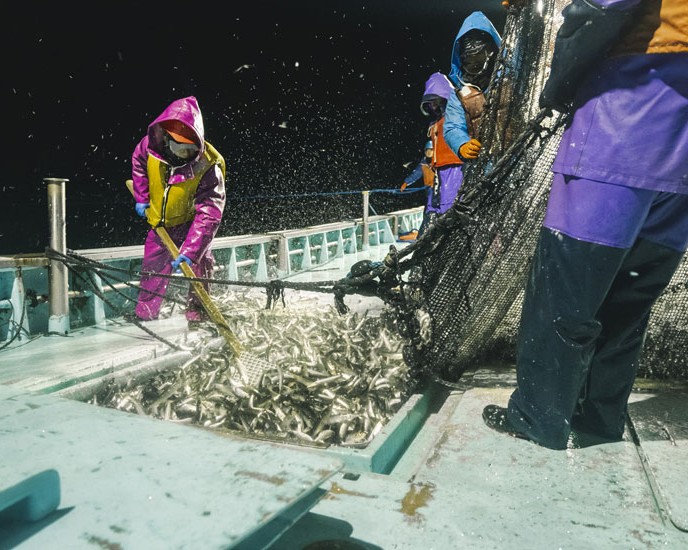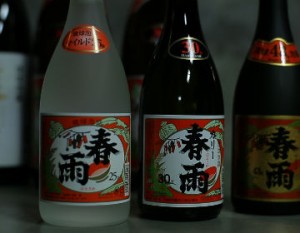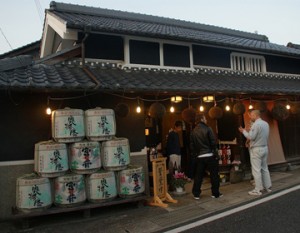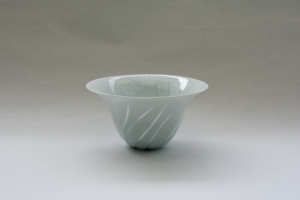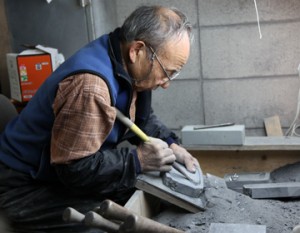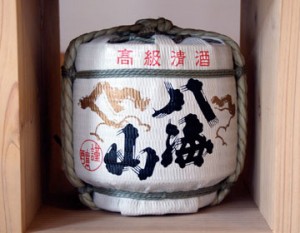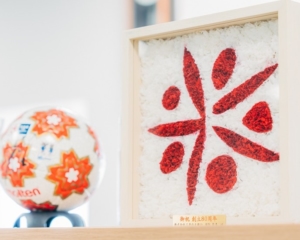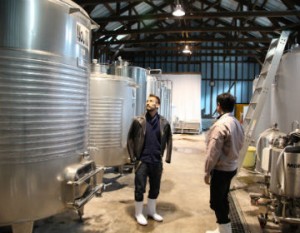The coastline of the Noto Peninsula is a prime fishing ground where fish from both warm and cold currents abound. At “Hinode Oosiki,” which carries on the traditional fixed net fishing of Noto, net master Nakada Yosuke leverages his expertise in preserving freshness to directly supply fish to many chefs. Nakada, who is passionate about the seas of Noto, continues to set sail every day.
A rich fishing ground where over 100 types of fish can be caught

In spring, there are sea bream and Spanish mackerel; in summer, tuna; in autumn, mackerel and sea bass; and in winter, yellowtail, cod, and sardines. The coastline of the Noto Peninsula is home to a rich fishing ground, with over 100 types of fish circulating in the market alone.
Why is the variety of fish caught in Noto so diverse? The answer becomes clear when looking at a map of Japan. Off the coast of the Noto Peninsula, located right in the middle of Honshu, flows the Tsushima Current from the south, bringing various fish such as sardines and mackerel. Meanwhile, migratory fish like yellowtail head southward from the waters off Hokkaido. In this way, a wide variety of fish gather off the coast of the Noto Peninsula from both the south and the north.
The traditional fixed-net fishing method of “Hinode Ooshi”

Noto Town, located at the tip of the Noto Peninsula in Ishikawa Prefecture, is a town known for its fixed net fishing. The history of fixed net fishing in this area dates back to the Muromachi period, and the Edo-period document “Noto Meiseki-shi” describes it as “the best fishing ground in Noto, where the catch is extremely abundant.”
The “Hinode Ooshi,” which operates fixed net fishing in Ukawa, Noto Town, boasts an annual catch of 2,000 tons. The fifth-generation net master, Nakata Yosuke, is known for his commitment to the quality of the fish he catches, earning him the trust of professional chefs.
Waiting for the fish and guiding them into the nets: fixed net fishing

At 1 a.m., the boat leaves the port, its engine rumbling as it heads toward the fixed nets set kilometers offshore. Hinode Ooshi has two fixed nets. As the boat cuts through the pitch-black sea, a row of round buoys marking the location of the nets comes into view. As the boat slows down, a flock of seagulls can be seen dancing in the air. “If there are seagulls, that means there are plenty of fish,” says Nakata with a smile.

The fixed net is approximately 500 meters long and 100 meters wide. Perpendicular to this net is a “fence net.” “The fence net is an obstacle that hangs down into the sea like a curtain. It is about 1,000 meters long. It blocks the fish’s path and lures them into the fixed net,” Nakata explained.

Set net fishing is done in pairs of two boats. One boat pulls the net’s rope while gradually narrowing the opening of the net. As the two boats come close to each other, a large school of sardines trapped at the back of the net becomes visible. A large net is lowered into the silver-colored swarm on the water’s surface, and the fish are quickly scooped up and lifted out by a crane.
“Nerve-pinching” to preserve freshness

A fisherman pulls a fish from the net. He inserts a thin pick into the fish’s forehead, cuts the gills, and threads a wire through the forehead into a tro box. The entire process takes just a few seconds. The fish, which was struggling moments ago, now lies quietly in the icy water.
At Hinode Ooshi, they select the best tuna, yellowtail, cod, and other fish and perform “nerve pinning” and “bloodletting.” Nerve pinning is a method of preserving the freshness of fish. A pick is inserted between the eyebrows to induce brain death, then a wire is threaded along the spine to sever the nerves, causing instant death.
“Fish that undergo nerve pinning experience delayed rigor mortis. This allows the energy components in the flesh to convert into umami flavor over a longer period, enhancing the taste,” explains Nakata-san. Bloodletting, which involves cutting the gills and draining the blood, is another essential process for maintaining freshness. It also helps eliminate any unwanted flavors and enhances the fish’s aroma.
To perform these processes efficiently and reliably on board, skilled techniques and experience are essential. The freshness and taste of the fish depend on the skill of the fishermen.
Cooking begins with “catching”

Mr. Nakata has deep connections with chefs. Through his collaboration with the head chef of a renowned sushi restaurant, he has studied onboard processing and temperature control methods, and has built relationships with many chefs, including those at Michelin-starred restaurants in Tokyo.
Sometimes chefs come to observe fixed net fishing, and other times Nakata visits restaurants to taste their dishes. “Cooking is a collaborative effort, from catching the fish to serving it on the plate. My job is to deliver the fish in the best possible condition to the chefs.” By knowing how the fish he catches will be cooked, he can perform the optimal processing. “Cooking begins on the boat,” is Nakata’s philosophy.
Overcoming the harsh circumstances surrounding the fishing industry

The environment surrounding the fishing industry is becoming increasingly harsh due to climate change, overfishing, and rising prices. According to Nakata, “In the last 30 years, the price of boats has increased 2.5 times. All other expenses have also risen, but fish prices are lower than they were 30 years ago.”
At Hinode Ooshi, they have been enhancing the value of fish through onboard processing methods like nerve-pinching, aiming for “quality over quantity.” They have also installed fish finders on fixed nets for monitoring and are streamlining operations to reduce unnecessary fishing.
However, there are limits to self-help efforts. “In an era where cheap and delicious food is taken for granted, cheap prices mean that someone else is bearing the burden. Consumers should be aware of this, and if the system related to food is not improved, the fishing industry will not be able to survive,” Nakata emphasizes.

Efforts are also underway to ensure that fishing remains a sustainable industry for the future. One such effort is resource conservation. Fixed net fishing, which involves waiting for fish to enter the nets, is considered a resource-friendly fishing method. However, to more actively protect resources, the company has widened the mesh size of its nets to allow smaller fish to escape and established a two-month fishing moratorium during the summer when juvenile fish are abundant. These measures aim to coexist with the rich seas of Noto.
Another initiative is to create a future where children can choose to become fishermen. Hinode Ooshi offers monthly salaries, two days off per week, and summer and winter bonuses, providing the same benefits as a typical company employee. “When we visit local elementary schools to give lectures on fishing, the children listen with shining eyes. Making fishing an attractive profession is the responsibility of our generation,” says Nakata.
Aiming for recovery from the Noto Peninsula Earthquake and resuming fishing operations quickly
In the 2024 Noto Peninsula Earthquake, Noto Town, where Hinode Ooshi is based, suffered significant damage. Tsunamis struck, destroying infrastructure, and people were forced to live in evacuation centers with an uncertain future.
While the wharf and workspaces were damaged, the boats remained intact. Nakata-san coordinated with various parties to secure fuel and ice for the boats, and decided to resume fishing just one week after the disaster.
“Even after deciding to resume fishing, I couldn’t sleep, torn by doubts. Was it right to work in such a situation? Who would be happy about this?” On the other hand, I also thought that if no one took the first step, even one day sooner, it would be very difficult to move toward recovery.” When he set out to sea and raised the nets, smiles spread across the deck for the first time in a long while. The first step taken by the sunrise net was the first step toward the port town’s revival.
Pride in Noto’s ingredients. A new challenge for town development

Since the earthquake, people have continued to leave Noto Town. Nakata believes that “if new challenges emerge in the town, people will return.” One such challenge is “community building through food.” He wants to make the local people aware of the value of Noto’s fish and that it can compete with fish from top restaurants, thereby restoring pride in the town.
Whether this will take the form of running a restaurant or holding events has not yet been decided. Mr. Nakata is envisioning various plans, including involving chefs he knows, to “make the town more enjoyable through food.”
“I’m itching to try various challenges right now.” From his experience of being among the first to return to fishing after the earthquake, Mr. Nakata knows firsthand that taking the first step can lead to expanding networks and spreading smiles. The challenge to restore pride and vitality to the town has only just begun.



